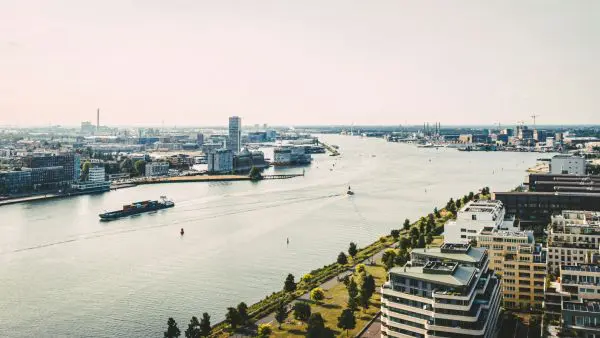This Amsterdam office is one of the world’s most sustainable buildings
Posted on: 13 January, 2025

If you think of sustainable buildings, you might picture places like London, Shanghai and New York. But did you know that the most sustainable and smartest building in the world is located in Amsterdam?
In another win for Europe, with Gothenburg being named the most sustainable city in the world, The Edge, located in the Netherlands, has been considered one of, if not the greenest building on the planet for the best part of a decade.
But what exactly is it about The Edge that has made it not only a shining example of sustainable construction but also a successful demonstration of the smart building concept, too?
About The Edge
The Edge is a 14-storey office building in Amsterdam. Constructed in 2014, it was designed by PLP Architecture and created by EDGE Technologies (formerly OVG Real Estate) for its main tenant, professional services giant Deloitte. According to PLP Architecture, the project had ‘two ambitions’ – to bring together Deloitte’s employees in the country that had previously been spread across multiple locations, and to create a smart building that acted ‘as a catalyst for Deloitte’s transition into the digital age’.
Learn more: Smart buildings, explained – here’s what they mean for the built environment
What makes The Edge so smart?
Smart buildings make use of technology like artificial intelligence (AI), automation and The Internet of Things (IoT) to monitor, capture data and continuously optimise the performance of a building.
For instance, the Burj Khalifa, the world’s tallest building, continuously monitors its air conditioning systems to identify faults and reduce maintenance hours, while Singapore’s Capital Tower is fitted with motion detectors that measure occupancy and adjust conditions for rooms, such as temperature or lighting, accordingly.
The design and construction of The Edge took these concepts and integrated them throughout its design and operations. This ambitious building has 28,000 sensors, all of which are connected to a network that continuously monitors conditions, usage and occupancy. It can also flag maintenance work to facilities teams (preventing higher repair costs, safety risks or downtime) and even tell cleaners to skip rooms that haven’t been used.
How The Edge is so sustainable
Along with helping to improve the conditions of a building for the end user, smart technologies are integral to why The Edge has become widely known as one of the world’s most sustainable office buildings. It received a 98.4% score from Building Research Establishment Environmental Assessment Method (BREEAM), which was at the time the highest score ever received by a building.
Learn more: Understanding green building certifications: why should you get one?
Here are just a handful of the sustainable technologies that helped The Edge achieve this score:
1. Dashboards
The data and information collected from The Edge’s 28,000 sensors is processed by Deloitte’s dashboard, giving an accurate and detailed overview of how people interact with the building.
For facilities teams, this gives them the insights they need to make decisions that can reduce energy consumption, such as shutting off sections of the building at certain times.
2. Solar panels
The Edge is designed to take maximum advantage of natural light, with large windows exploiting sunlight and 6,000m2 of solar panels simultaneously providing energy and protection from solar radiation.
As a result, The Edge consumes 70% less electricity than typical office buildings.
3. A smartphone app
When a Deloitte employee arrives at The Edge, the building recognises their car and automatically directs them to an available parking space. The building’s app then helps them find a desk (none of the employees in the building have their own desk – instead, workspaces are assigned based on schedules). Once they’re in the office, they can even use the app to adjust the conditions of their meeting room.
This is more than just a gimmick. Alongside the building’s sensors and dashboards, this allows the use of The Edge to be optimised while simultaneously supporting the needs of its inhabitants.
4. Low-emission lighting
The Edge is equipped with over 6,000 low-energy and low-emission LED lights that make up part of its interactive lighting system.
This also works in tandem with the building’s dashboard and sensors, meaning lights in unoccupied rooms can be switched off and energy consumption can subsequently be reduced.
Final thoughts
Many other sustainable office buildings have followed in the footsteps of The Edge, such as Bloomberg’s striking headquarters and the JJ Mack building, both in London, UK. Yet after almost 10 years, it remains a shining example of the built environment’s future and the potential cutting-edge technology has for sustainability.






